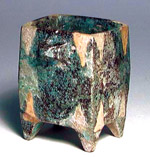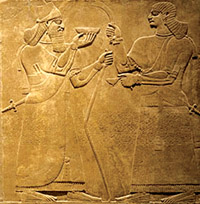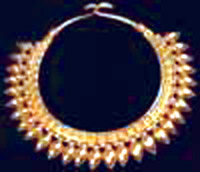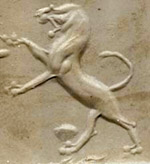Looking back
The Assyrian Empire
When tracing the long history of Assyria it is clear that the kingdom
which initially began around the region on the Upper Tigris River in the
Middle Bronze Age, grew to become a powerful empire later, spanning from
2400 BC to 612 BC.
|

A gold bowl with the motif of a flower |
|

Artwork depicting a warrior |
The original capital was named Assur (also written as Ashur) after
their chief God Ashur, and the entire area came to be known as Assyria
eventually. The new State grew around four cities; Ashur, Arabela,
Nimrud (or Calah) and Nineveh. The rulers of Assyria moved their kingdom
from the hot-desert region of Ashur to the cooler region of Nineveh.
Assyrian history could be divided into six periods, such as Emergence
- beginning: 2400 BC, the first Golden Age: 2400 BC - 612 BC, the first
Dark Age: 612 BC - 33 AD, the Second Golden Age: 33 AD - 1300 AD, the
Second Dark Age: 1300 AD to 1918 AD and finally Diaspora: 1918 AD to the
present.During the long history of Assyria, they were subjugated
(conquered) most of the time by more powerful kingdoms and people of the
southern region.
|

A container made of gold |
|

A rare container |
The Assyrians are a semetic people indegenous to Mesopotamia; they
are Mediterranean Caucasoids and are ethnically distinct from Arabs and
Jews. They are known as a race of warriors who were cruel and brutal
than any other race.
Assyrians were fierce warriors and used swords, slings, bows and
shields in war. They also used war chariots drawn by horses. Archers
fired at the enemy from them. The common language and art of Assyria
originated from Sumeria, but was modified over the years. In fact, the
Assyrians spoke two languages.
|

A fresco |
Initially their language was an Assyrian dialect of Akkadian (branch
of the
|

Gold burial jewellery from Nimrud tomb |
Semitic languages). Then later, they spoke neo-Syriac. Akkadian
was written in cuneiform writing in stone and clay slabs.
It was used from the beginning of the empire to about 750 BC. By
about 750 BC, a new form of writing was introduced on parchment, leather
and papyrus. The Armenians who brought this style of writing, saw to it
that Aramaic succeeded. In 752 BC, Aramaic was made the second official
language. But as it was infused with Akkadian words, scholars refer to
the language as Assyrian Aramaic.
It was in the Neo-Assyrian Empire, a period of Mesopotamian history
which began in 911 BC and ended in 612 BC, that Aramaic became a
language which was commonly spoken, by the people of the land.
|

A fresco |
|

Lion cylinder seal |
The Neo-Assyrian Period (911-612 BC) which succeeded the Middle
Assyrian period (14th-10th BC), is the last, but the most popular and
best documented period in the duration of the Assyrian Empire.
Assyrians established merchant colonies known as Karum (the Akkadian
word for port) in 1920 BC-1840 BC and 1796 BC - 1740 BC. Even though
Assyria was a minor kingdom in the Middle Assyrian period, it competed
for dominion with their southern Mesopotamian rival, Babylon.
It reached peak power with reforms of Tiglath-Pileser III who ruled
Assyria from 745-727 BC. During the 25th dynasty of Egypt, Assyria
became a serious threat to Egypt.
Even though not much information has been gathered about life in the
early periods, it is recorded that the Assyrians practised Ashurism and
Christianity as their religions.
|

Assyrian hunter |
|

Clay tablets with spells written on them |
The first religion was derived from the name of God Ashur and was
practised until 256 AD, with some of the people taking to Christianity.
Assyria is considered as the first nation to embrace Christianity. In
fact, records state that the first Assyrian church was founded in 33 AD
by Thomas, Bartholemew and Thaddeus.
Of all the rulers of Assyria, King Ashurbanipal who was the last
king, was considered as the greatest by many. He was a ruthless king,
but it is recorded that he built a great library where records and
literature from Sumer and Babylon were stored, on clay tablets. His
palace in Nineveh is believed to have contained a garden that was
stocked with plants from various parts of the world.
Assyrian art that has been discovered by archaeologists dates back to
the Neo-Assyrian period. There have been many stone reliefs depicting
battle scenes lining the walls of the royal palaces.
They are believed to have been done as propaganda showing the power
of the Assyrian emperor. Some stone artwork depicting the King with
different deities have also been discovered along with rare metal plates
that had been used to decorate wooden doors.
|

A relief done in exquisite detail |
|

Part of a fresco |
The sculpting skills too had reached a high standard during this same
period according to scholars. Some rare pieces of Assyrian jewellery too
discovered from this period are now housed in museums.
The Assyrians built magnificent cities, temples and palaces, and on
many occasions, the King had personally supervised these constructions
from his two-wheeled chariot.
Records show that the stones for construction were brought from
distant quarries. The stones were transported up the Tigris river by
oarsmen in skin boats who towed the stone-laden rafts.
It is the Assyrians who first used battering rams to knock holes in
the city walls during battle. They were skilled at seige warfare to
defeat their enemies. They also used excavation as a means to undermine
the strength of city walls in enemy territory.
The concept of corps of engineers who bridged rivers with pontoons
(flat bottomed boats or metal drums) or provided soldiers with
inflatable skins for swimming is believed to have been introduced by the
Assyrians.
Fact file
* Queen Shamiram (Samuramat), a Semiramis in Greek ruled the Assyrian
Empire for a period of five years from 810 BC to 805 BC.
* The Royal Tomb of Nimrud was discovered in April 1989. The tomb was
located in the North-West Palace of the Ancient City of Kalkhu.
* The city of Kalkhu was the capital of the Assyrian Empire for over
150 years until King Sargon moved his capital to Dur-Sharukin in 717 BC.
* Assyria did not become an independent state until about 1400 BC.
* Inscriptions were composed in Akkadian from the beginning.
* Few historical sources remain for the last 30 years of the Assyrian
Empire.
* Even though the Assyrian Empire ended in 612 BC, there are plenty
of historical records giving details of the continuous presence of the
Assyrian people till the present time.
* Located in North Mesopotamia, Assyria spans four countries. It
extends west to the Euphrates river in Syria, and extends north to
Harran, Edessa, Diyarbakir and Lake Van in Turkey. In Iran it extends
east to Lake Urmi and in Iraq it extends to about 100 miles south of
Kirkuk.
* The two great rivers that run through Assyria are the Tigris and
the Euphrates.
* The Assyrian Empire, particularly the third one, had a lasting
impact on the Near East.
* It is in Assyria that locks and keys were first used.
* The sexagesimal system of keeping time was developed in Assyria.
* The first guitars, the first magnifying glasses, the first
libraries, the first plumbing and flush toilets, the first electric
batteries, the first postal system, and the first paved roads are
believed to have originated in Assyria.
* Imperial administration - of dividing the land into territories
administered by local governors who report to the central authority, the
king of Assyria, is the fundamental model of administration that can be
seen in the Federal State system of America.
* One of the greatest Assyrian achievements in the fourth century is
the founding of the first university in the world. The school of Nisibis
had three departments, theology, philosophy and medicine.
* When Arabs invaded Middle East in 630 AD, they encountered 600
years of Assyrian Christian civilization with a rich heritage, a highly
developed culture and advanced learning institutions. |
